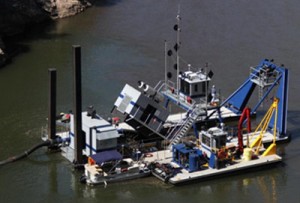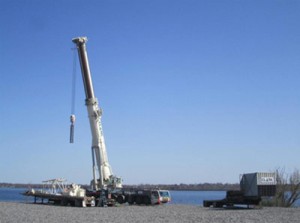As preparations continue for Onondaga Lake dredging and capping, another milestone is being reached this week with the arrival of the large hydraulic dredge that will remove material from the lake bottom. The dredge will be assembled over the next several weeks. Deliveries of additional barges, watercraft, office trailers, smaller dredges, and equipment also began this week and will continue in the coming weeks.
Dredging will be conducted from barges on the lake. The dredged material will be transported via a double-walled pipe through non-residential areas to the lined consolidation area in Camillus where it will be pumped into geotextile tubes for drying and safe, long-term isolation. The “closed system” will prevent lake material from being exposed to the open environment.
The dredge has state-of-the-art electronic systems, including a global positioning system (GPS), computerized tracking software, and automated control system, as well as a 16-inch pump. Once assembled, the dredge, which measures nearly 40 feet by 104 feet, will be launched. The complete system – including the dredge, pipeline, processing equipment, and water treatment plant – will then be tested. Later this summer, water will be used to test the system before the lake material is introduced. A limited amount of material will be processed initially before increasing operations to full capacity.
At the consolidation area, the lake material will be separated from the water using geotextile tubes. The water will be collected and treated to meet New York State Department of Environmental Conservation (DEC) standards. A high-strength liner has been placed on a clay layer at the bottom of the consolidation area. Once the lake cleanup is complete, an additional high-strength liner will be placed above the geotextile tubes. Above this liner, layers of clean soil will be added and vegetation will be planted.
During dredging operations, B20 biodiesel fuel will be used instead of standard diesel fuel. In addition, during the Onondaga Lake cleanup, green electric booster pumps and hydraulic dredging will help reduce greenhouse gas (GHG) emissions by the equivalent of removing 12,700 cars from the highway for one year.
More than 500 Central New York scientists, engineers, and skilled craft laborers are working with Honeywell, achieving significant progress executing lake improvement plans under the jurisdiction of the DEC.
Comprehensive efforts to protect the public’s health and safety are an important part of every stage of the work to restore Onondaga Lake. All community-related health and safety plans are submitted to the DEC, the U.S. Environmental Protection Agency, and the New York State Department of Health. A comprehensive Community Health and Safety Plan is being developed for lake cleanup operations.
Individuals interested in more information should contact Honeywell at 315-552-9784. For more information on the Onondaga Lake cleanup, visit www.lakecleanup.com.







